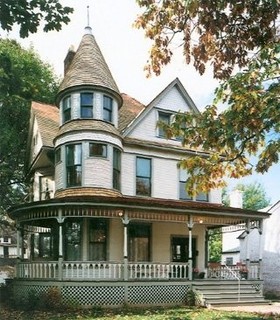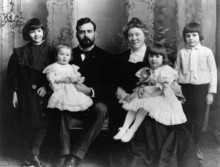Ernest Hemingway Birthplace Museum
Introduction
Text-to-speech Audio
Images
The house on North Oak Oak Avenue where Ernest Hemingway was born and lived until age six.

The Hemingway family (Ernest far right).

Backstory and Context
Text-to-speech Audio
On July 21, 1899, Ernest Miller Hemingway was born the second child and first son to a wealthy family in the Chicago suburb of Oak Park, Illinois. Oak Park during the turn of the 20th-Century was a conservative Protestant refuge from the liberalness of Chicago. Frank Lloyd Wright and other influential architects were already leaving their modern marks on the small suburb when Hemingway came into the world. Urban legend has Hemingway describing Oak Park as “wide lawns and narrow minds,” but the authenticity of the quotes has never been determined.
Designed by architect Wesley Arnold and constructed in 1890, the Queen Anne style house in which lived his parents, great uncle Benjamin Tyley Hancock, and maternal grandfather was the first home in Oak Park to have electricity. He was named after his maternal grandfather Ernest Hall and Great Uncle Miller Hall. His father, Dr. Clarence Hemingway, was a local physician and his mother, Grace Hall Hemingway, was an accomplished vocalist and pianist who taught musical lessons from home. Both parents exhibited bouts of manic-depression and psychological instability. It was during these formative years while living in the Oak Park Avenue house that his parents began influencing his personality and adult persona and subsequent literary style.
His father, Dr. Clarence Hemingway, was a man’s man and a skilled outdoorsman. The Hemingways owned a summer home called Windemere on Lake Michigan, where the family would spend their summers. It was here that Clarence instilled in his son a love and appreciation of nature, teaching him how to hunt and fish. This love of nature became a common theme found in many of Hemingway’s literary works. However, Clarence was also a very rigid authoritarian who often exhibited violent outbursts towards his family and expected his son to exhibit manly behaviors. On the other hand, Hemingway’s mother Grace often displayed erratic behaviors and dressed his older sister and him as twins, sometimes as boys but often time as girls. These spontaneous and unwelcomed thrusts into gender fluidity combined with the forced manliness from his father created a conflicted identity for the author.
While suffering from the conflicting expectations from his parents, Hemingway often found refuge in the stories from his Uncle Tyley and Grandfather. Benjamin wTyley Hancock was a well-traveled man who recounted his stories and adventures to the young author, undoubtedly igniting Hemingway’s famous desire for adventure. When Benjamin Tyley Hancock passed away in 1933, Hemingway felt the loss deeply.
Ernest Hemingway spent only six years living in the Queen Anne house on Oak Park Avenue, but they were one of the most influential periods of his life. Hemingway was six years old when his live-in grandfather passed away. His parents sold the house and moved into a new, modern Prairie style house on nearby Kenilworth Street where Ernest lived until graduating from high school.
Throughout the rest of the 20th-Century, the former Hemingway residence fell into neglect. Then in December 1992, the Ernest Hemingway Foundation of Oak Park purchased the home and spent the next decade meticulously restoring the property to its Victorian Era condition during Hemingway’s childhood. The house now serves as a museum, open Wednesday through Sunday.
Sources
Hemingway's Oak Park Roots. The Ernest Hemingway Foundation of Oak Park. December 14, 2018. https://www.hemingwaybirthplace.com/hemingway-and-oak-park/.
Ernest Hemingway Birthplace and Museum. Museums of the World. December 14, 2018. http://museu.ms/museum/details/526/ernest-hemingway-birthplace-and-museum.
Adams, Matthew. Ernest Hemingway: The man behind the cultivated image of hyper-masculinity. The Washington Post. May 17, 2017. December 14, 2018. https://www.washingtonpost.com/entertainment/books/ernest-hemingway-the-man-behind-the-cultivated-image-of-hyper-masculinity/2017/05/17/c54e1aae-3b04-11e7-8854-21f359183e8c_story.html?noredirect=on&utm_term=.6017103f63ca.
The Life of Ernest Hemingway. Ernest Hemingway. December 14, 2018. http://www.umich.edu/~eng217/student_projects/nobel%20prize%20winners/hemingway.htm.
Ernest Hemingway Biography> Childhood. The Hemingway Resource Center. December 14, 2018. http://www.lostgeneration.com/childhood.htm.
Guerin, Michael P. Hemingway Conference 2016. Oak Park Forest River Museum. July 2016. December 14, 2018. http://oprfmuseum.org/this-month-in-history/hemingway-conference-2016.
